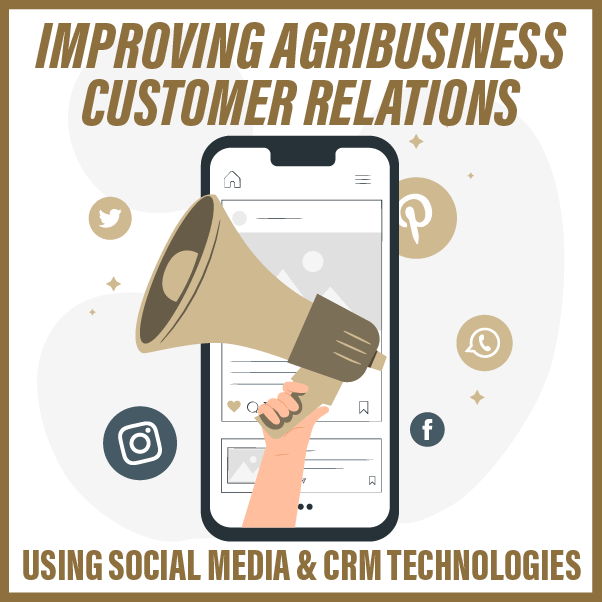Improving Agribusiness Customer Relations Using Social Media & CRM Technologies
 Reviewer
Reviewer
Mati Mohammadi, PhD Student & Graduate Research Assistant, Purdue University Department of Agricultural Economics
See more from Mati on Twitter or LinkedIn.
Article
Social media and customer relationship management technologies: Influencing buyer-seller information exchanges. Omar S. Itani, Michael T. Krush, Raj Agnihotri, Kevin J. Trainor
Journal
Industrial Marketing Management (2020)
Summary
To reduce information asymmetry and increase trust and efficiency, sharing information and communication is essential and the key to successful relationships in the industry. This article by Itani et al., recently published in Industrial Marketing Management, addressed the importance of effective information exchange between buyers and suppliers for a successful sale. In addition to explaining the incentives for sharing information, they demonstrated how new technologies help information sharing and co-create value. Their article examined the effect of customer relationship management (CRM) and social media technologies used by sellers on buyer information sharing in a business-to-business (B2B) context. The authors studied the impact of these different technology tools on the salesperson tasks of market-sensing and customer-linking.
CRM technology helps salespeople to reduce amounts of data and convert it to organized data. Salespeople can then share this practical data with buyers via efficient methods they have determined. On the other hand, social media technology helps salespeople to discover information about their competitors and their customers’ reactions.
This study found that:
- There is a positive effect of sellers’ social media utilization on the sellers’ competitive information collection.
- Sellers’ CRM technology utilization is positively associated with product information communication and buyers’ information sharing intentions.
- Sellers’ product information communication efforts are positively related to buyers’ information sharing intentions and product information communication.
- The interaction term (seller social media utilization and customer relationship management technology utilization) positively affects sellers’ competitive information collection.
What this means for Food and Agricultural Business
In recent years, we have seen a rapidly increasing demand for information in the agriculture sector. New and more diversified information sources, which mainly stem from embracing the internet and IT developments, add more complexity to this subject. While this study’s results are from a sample of sales organizations located in India, they are still relevant in the agribusiness sector. Farmers are potential buyers in the B2B market; therefore, receiving information from farmers to analyze the market and provide them with new information about products is an important part of the buyer-seller relationship in the B2B context.
In the agribusiness sector, we can explore the questions of why farmers should share information with suppliers and what the preferred methods of communication are that agribusiness firms should use. Aligned with this paper’s findings, farmers are more likely to exchange data with suppliers when the rewards of doing so exceed the cost of sharing this information. The benefits farmers experience when sharing information are crucial to consider. For example, positive feedback from their interactions such as changes in input and output price and increase in yield will encourage them to repeat this process.
This study reveals that, overall, social media and CRM technologies positively affect sellers’ and buyers’ information exchange relationships. Additionally, it was found that the utilization of these technologies positively affects sellers’ competitive information collection; however, the impact of these technologies on buyers’ intention to share information are not similar. Sellers’ social media utilization has no effect on buyers’ intention to share information, but CRM utilization positively relates to buyers’ information sharing intention.
We can also extend these results to relate to the agribusiness sector. For example, food and agribusiness firms have the opportunity to use social media and CRM technologies to collect competitive intelligence. These technologies facilitate access to data and information about customers’ responses to their own and competitors’ strategies, as well as new products for agribusiness firms. Social media and CRM technologies make it easier to collect a wide range of data for a lesser cost than other methods. They also add the ability to eliminate extra and impractical information before analyzing it and making decisions.
Based on the 2017 Large Commercial Producer Survey conducted by the Purdue University Center of Food and Agricultural Business, it was found that in order to find the preferred method for delivering information, farmers’ sociodemographic attributes such as farm size, age and education[1] must be considered. For instance, our study showed a difference in preferences between crop and livestock farmers in receiving information from suppliers. Consistent with this paper’s findings, our survey’s results showed that social media technologies such as LinkedIn, Twitter and Facebook are the least preferred methods of receiving information among U.S. farmers. At the other end of the spectrum, university publications, general farm magazines and field days are the top three most preferred information sources by farmers.
Footnotes
[1] Mohammadi M, Gunderson M, Downey S. Which Factors Affect the Importance of Information Sources among U.S. Farmers? Poster presented at: at the Agricultural & Applied Economics Association’s 2019 AAEA Annual Meeting; Atlanta, GA, July 2019.
RELATED POSTS:
A trifecta of strategies for agribusinesses amidst unprecedented change
In navigating unprecedented change, agribusinesses must prioritize prediction, adaptability, and resilience to thrive in evolving markets.
The impact of diversification strategies on small and medium enterprises
Exploring diversification and its impact on businesses—insights for strategic resilience amid market uncertainties.
Navigating Resilience: Challenges and strategies in U.S. agricultural and food supply chains
Agribusinesses must balance resilience and efficiency amid disruptions, navigating complex trade-offs and policy impacts for sustainable supply chains.
